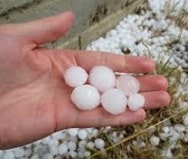The first thing we are going to do before delving into the meaning of the term hail is to know its etymological origin. In this case, we can state that it is a word that comes from Latin, exactly from "granun", which can be translated as "seed" or "grain".
Frozen water that falls from the clouds in the form of grains of different sizes is called hail . This is a precipitation different from snow , which falls as flakes.
 Hail, therefore, is solid precipitation . It is made up of small spheres of ice , with a usual diameter of between five and fifty millimeters. Hail is generated in cumulonimbus clouds.
Hail, therefore, is solid precipitation . It is made up of small spheres of ice , with a usual diameter of between five and fifty millimeters. Hail is generated in cumulonimbus clouds.
For the formation of hail to occur, there are solid particles that the ascending winds drag into the cumulonimbus, where water particles adhere to them. As these particles rise, the temperature drops and freezing occurs. Once the hail is formed, when it reaches the upper sector of the cumulonimbus it falls towards the surface due to its weight.
In some cases, when the hail begins to descend through the cloud, it thaws and becomes liquid. Another updraft can deposit it again in the upper part of the cloud, where water is again added and freezes. In this way, the hail adds layers until, with sufficient weight, it precipitates.
There are some corners of the planet where hail often occurs. Specifically, we can highlight places such as southern Chile, cities like Potosí and Quito, southern Australia, Serbia, Croatia...
Another singularity that is worth knowing about hail is that the clouds that release them are very characteristic. Specifically, they are identified because they have vertical shapes and because they are composed of a column of humid and warm air that has the peculiarity of rising in a spiral shape.
Hail can cause various problems. The fall of these ice spheres can cause injuries to people and property damage to the roofs of houses and cars, for example. This is due to the violence of the impact due to the speed of the fall and the weight of the ice. By accumulating on the surface, hail also causes other disorders, including difficulties moving on public roads or blocking drains.
In the same way, we cannot ignore that hail storms cause a lot of damage in the countryside since, in addition to injuring livestock, they can destroy crops .
It is curious to know that during the Middle Ages people tried to avoid hail storms. What methods were used for this? Well, from firing cannons, because it was believed that their fire could prevent those, to ringing the church bells.
However, from that time until now, different methods have been tried to avoid the aforementioned hail storms. However, we cannot ignore that so far none of these have been really effective.
